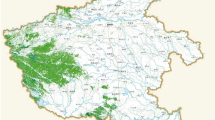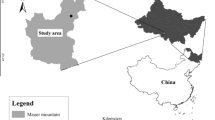Abstract
The moisture content of dead forest fuel is an important indicator of risk levels of forest fires and prediction of fire spread. Moisture distribution is important to determine wild fire rating. However, it is often difficult to predict moisture distribution because of a complex terrain, changeable environments and low cover of commercial communication signals inside the forest. This study proposes a moisture content prediction system composed of environmental data collected using a long range radio frequency band 433 MHz wireless sensor network and data processing for moisture prediction based on a BP (back-propagation) neural network. In the fall of 2019, twenty nodes for the collection of environmental data were placed in four forest stands of Maoershan National Forest for a month; 7440 sets of data including temperature, humidity, wind speed and air pressure were obtained. Half the data were used as a training set, the other as a testing set for a BP neural network. The results show that the average absolute error between the predicted value and the real value of moisture content of fuels of Larix gmelini, Betula platyphylla, Juglans mandshurica, and Quercus mongolica stands was 0.94%, 0.21%, 0.86%, 0.97%, respectively. The prediction accuracy was relatively high. The proposed distributed moisture content prediction method has the advantages of wide coverage and good real-time performance; at the same time, it is not limited by commercial signals and so it is especially suitable for forest fire prediction in remote mountainous areas.















Similar content being viewed by others
References
Alves MVG, Batista AC, Soares RV, Ottaviano M, Marchetti M (2009) Fuel moisture sampling and modeling in Pinus elliottii Engelm. plantations based on weather conditions in Paraná - Brazil. Iforest 2(1):99–103
Ferguson SA, Ruthford JE, McKay SJ, Wright D, Wright C, Ottmr R (2002) Measuring moisture dynamics to predict fire severity in longleaf pine forests. Int J Wildl and Fire 11(4):267–279
Han BF, Liu YB, Zhang C, Chen YW, Ma R, Ma F (2014) Changes of microclimate and relation between microclimate and soil water under different ecological restoration measures in typical steppe of south Ningxia. J Agric Sci 35(04):8–13 (In Chinese)
Hu HQ, Luo SS, Luo BZ, Su ZW, Wei SJ, Sun L (2017) Forest fuel moisture content and its prediction mode. World for Res 30(3):64–69 (In Chinese)
Hu HQ, Luo BZ, Luo SS, Wang ZS, Su ZW, Wei SJ (2018) The prediction of moisture content of surface ground fuel of typical forest stand in Daxing’anling mountains. J Central South Univ for Technol 38(11):1–9 (In Chinese)
Jia JP, He XQ, Jin YJ (2009) Statistics (4th edition). Beijing: China Renmin University Press, p 374 (In Chinese)
Jin S, Zhou Y (2014) Study on moisture content prediction model of dead surface fuels in typical stands, Kunming. J Central South Univ for Technol 34(12):7–15 (In Chinese)
Li HY, Hu HQ, Sun L (2016) Research on relational models of moisture content of dead forest fuel with meteorological factors and soil factors in China. For Eng 32(3):1–6 (In Chinese)
Lin XN, Wang XY, Ding Y (2010) Experiment on neural network prediction modeling of far Infrared radiation drying for Agaricus bisporus. Trans Chin Soc Agric Mach 41(05):110–114 (In Chinese)
Lu XY, Niu SK (2010) Ren YM (2010) The Relationship between Fuel moisture and meteorological factors in Beijing Xishan Forest Centre. For Resources Manag 3:79–86 (In Chinese)
Ma LF, Li WB, Zhang JG (2011) Li HX (2011) Study on the prediction of the moisture content of several forest surface combustibles. Human Agric Sci 3:127–128
Maffei C, Menenti M (2019) Predicting forest fires burned area and rate of spread from pre-fire multispectral satellite measurements. ISPRS J Photogramm 158(2019):263–278
Marsdensmedley JB, Catchpole WR (2001) Fire modelling in Tasmanian buttongrass moorlands III-Dead fuel moisture. Int J Wildl and Frie 10(2):241–253
Nolan RH, Hedo J, Arteaga C, Sugai T, Dios VRD (2018) Physiological drought responses improve predictions of live fuel moisture dynamics in a Mediterranean forest. Agr Forest Meteorol 263(2018):417–427
Oumar Z, Mutanga O (2010) Predicting plant water content in Eucalyptus grandis forest stands in KwaZulu-Natal, South Africa using field spectra resampled to the Sumbandila Satellite Sensor. Int J Appl Earth Obs 12(2010):158–164
Qi Y, Dennison PE, Jolly WM, Kropp RC, Brewer SC (2014) Spectroscopic analysis of seasonal changes in live fuel moisture content and leaf dry mass. Remote Sens Environ 150(2014):198–206
Ruffault J, St Paul NM, Pimont F, Dupuy JL (2018) How well do meteorological drought indices predict live fuel moisture content (LFMC)? An assessment for wildfire research and operations in Mediterranean ecosystems. AGR for Meteorol 262(2018):391–401
Schunk C, Wastl C, Leuchner M, Menzel A (2017) Fine fuel moisture for site- and species-specific fire danger assessment in comparison to fire danger indices. Agr for Meteorol 234–235:31–47
Sérgio MGL, Domingos XV, Maria TV, Luís TL (2006) Moisture content of fine forest fuels in the Central Portugal (Lousã) for the Period 1996–2004. For Ecol Manag 234:S71
Slijepcevic A, Anderson WR, Matthews S, Anderson DH (2015) Evaluating models to predict daily fine fuel moisture content in eucalypt forests. For Ecol Manag 335(335):261–269
Sun N, Zhang YC, Mao WM, Xiong X, Hu QH (2020) Design of automatic meteorological station based on elastic compute service. Modern Electronics Tech 43(15):148–151
Wang HJ, Luan ZP (2014) Development of a larch forest land surface fuel moisture rate prediction model. Forestry Labour Safety 27(4):24–27
Wang C, Gao HZ, Cheng S, Lu DL, Chang WQ (2009) Study on water content of forest fuel and forest fire risk prediction in Saihanba forest area. China for Sci Technol 23(3):59–62
Wang YL, Shi Y, Li CW (2020) Model of relationship between moisture content of forest combustible and meteorological factors in Fengning County of Hebei Province. Modern Agric Res 26(7):91–93 ((In Chinese))
Zhang SY, Cai JB (2006) Chen XM (2006) Response models on the moisture change of surface fuel to fire environment in Cunninghamia lanceolata young plantation. J Zhejiang for Coll 4:439–444 (In Chinese)
Zhang H, Jin S, Zhang YL, Yu HZ (2016) Meteorological elements regression method is used to predict Pangu forest farm extrapolation accuracy analysis of fuel moisture content. J Central South Univ for Technol 36(12):61–67 (In Chinese)
Zhang H, Ma SH, Kang P, Zhang QL, Wu ZW (2020a) Spatial heterogeneity of dead fuel moisture content in a Larix gmelinii forest in inner Mongolia using geostatistics. J for Res 32:569–577
Zhang R, Hu HQ, Qu ZL, Hu TX (2020b) Diurnal variation models for fine fuel moisture content in boreal forests in China. J for Res 32:1177–1187
Zhao L, Yebra M, Dijk AIJMV, Cary GJ, Matthews S, Sheridan G (2021) The influence of soil moisture on surface and sub-surface litter fuel moisture simulation at five Australian sites. Agr for Meteorol 108282(2021):298–299
Zheng H, Yang YB, Yang K, Liu JB, Jin S (2013) Dynamic research on the forest foul moister content in Harbin urban forestry demonstration base in spring. For Labour Safety 26(4):34–38 (In Chinese)
Zhou ZC, Liu AJ, Zhao LS, Wang Y, Sun L (2016) The relationship between typical stand surface dead fuel moisture and meteorological factors-taking harbin city forestry demonstration based on typical combustible case as an example. For Sci Technol Inf 48(2):4–8
Author information
Authors and Affiliations
Corresponding authors
Additional information
Corresponding editor: Yu Lei.
Publisher's Note
Springer Nature remains neutral with regard to jurisdictional claims in published maps and institutional affiliations.
Project funding: This work was supported by the Fundamental Research Funds for the Central Universities (Grant No. 2572020AW43; NO. 2572019CP19), the National Natural Science Foundation of China (Grant No. 31470715), the Natural Science Foundation of Hei-longjiang Province (Grant No. TD2020C001), and the project for cultivating excellent doctoral dissertation of forestry engineering (Grant No. LYGCYB202009).
The online version is available at http://www.springerlink.com
Rights and permissions
About this article
Cite this article
Peng, B., Zhang, J., Xing, J. et al. Distribution prediction of moisture content of dead fuel on the forest floor of Maoershan national forest, China using a LoRa wireless network. J. For. Res. 33, 899–909 (2022). https://doi.org/10.1007/s11676-021-01379-9
Received:
Accepted:
Published:
Issue Date:
DOI: https://doi.org/10.1007/s11676-021-01379-9




